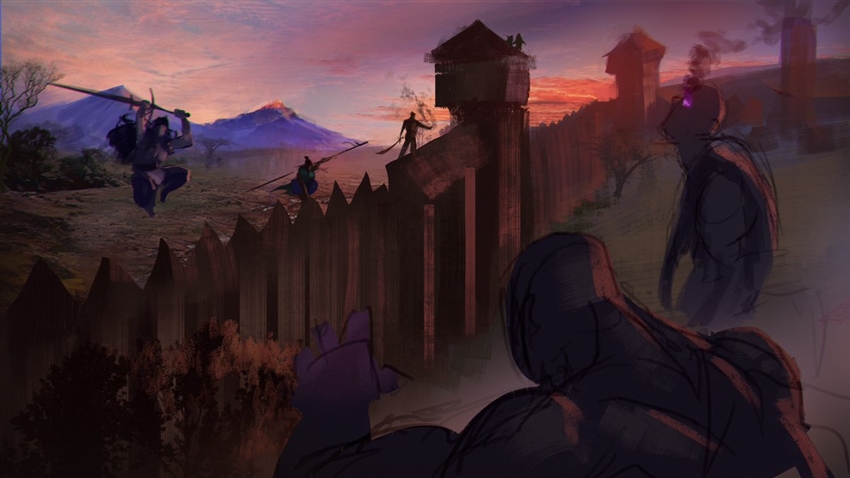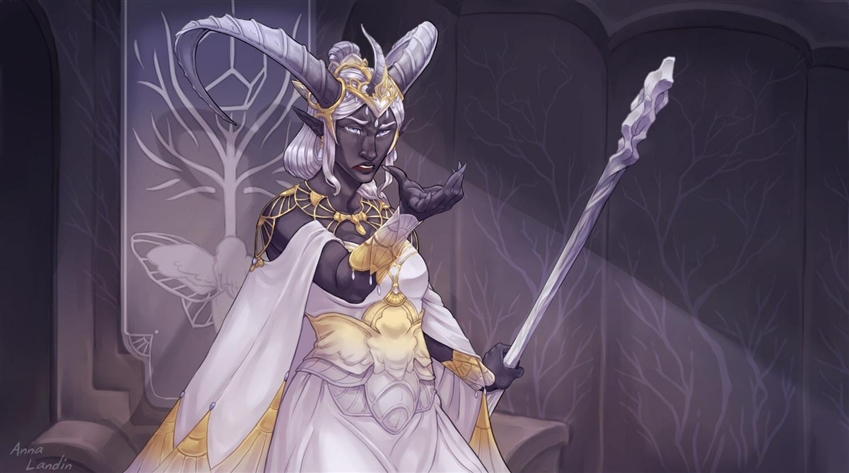This week on Critical Role, the Mighty Nein adopted an unusual tactic to complete their quest, and made a tenuous new ally.
Episode Summary
Previously on Critical Role, the Mighty Nein accepted a quest on behalf of Professor Waccoh of the Marble Tomes Conservatory, a library deep in Ghor Dranas, capital of the Kryn Dynasty. They were to travel through the Vermaloc Wildwood and eliminate a tribe of stone giants that had not only taken over the Icozrin Steelworks, but halted the progress of a Xhorhasian war machine traveling across the wastes. They attempted to stealthily approach the camp, but accidentally alerted their sentries, who roused their companions inside the palisaded structure the giants had camped in. The element of surprise was lost.
This week, Yasha charged straight at the giants. Fjord broke cover and rushed the treeline at the same time as his ally—and initiative was rolled! The giants had two warriors and a shaman of some sort, and the Mighty Nein—now 9th level!—brought all of their most powerful spells and fighting skills to bear against them. However, before the fight got too bloody, Caduceus, Fjord, and Jester used their magic to quell the combat and speak to them. The giants weren’t too friendly, but they explained that they came down from the mountains because something terrible drove them from their home. Things with wings and long faces. They feared them, but they did truly wish to go home.
The giants didn’t trust the Mighty Nein, but they valued their strength if they truly wished to help defeat the invaders. The leader of the giants agreed to travel with them, but the rest of the giants refused; they would not leave their camp empty so that the drow could retake their new home. The Mighty Nein moved out—and Beau thought of the foes the giants described. She thought back to her studies and recalled the mosquito-like demons known as chasmes, and shuddered. “I hope it’s not that,” she grumbled.
They traveled deeper into the Vermaloc Wildwood and up into foothills, and then mountains. With the giant leader Suna close behind them, they ventured into the caves that the stone giants once called their home. There, they were attacked by fiendish creatures and forced into a challenging combat. The chasme demon’s whining hum nearly incapacitated the party, but they managed to resist its hypnotic buzz and finish the fight.
The chasme and its minions defeated, the Mighty Nein healed up and traveled deeper into the cavern. There they found the corpse of one of the stone giants near another planar rift—though this one seemed to peer into a realm filled with trees—and all of their branches were writhing serpents! Surely, this was another part of the Abyss. Yasha raised the magician’s judge and sealed the rift with a single stroke of her mighty greatsword—but the corrupting energies of the Abyss surged into the nearby giant’s corpse. The behemoth rose, now a hulking undead monstrosity, and smiled wickedly at its prey.

Art by Caio Santos (@BlackSalander)
Spotlight: Combat into Negotiations
Ending a combat by trying to negotiate with enemies—especially enemies that are difficult to communicate with—is a process that isn’t very well described in the rules of D&D. What does it take to end a combat and start negotiations? Is a simple Charisma (Persuasion) check opposed by the enemy commander’s Wisdom (Insight) check all it takes? If so, what penalties are imposed upon this check?
On one hand, it’s unfortunate that this intersection of the game’s Combat and Interaction pillars is so ill-defined and subject to DM fiat. On the other hand, it can be a blessing that this system relies on fiat, since trying to codify all the different edge cases of socially halting a combat would create a nightmarishly complex subsystem of the rules. The advantage of having a codified system—even if that system is just a house rule—is that the players never feel like you’re bending the rules to accommodate their actions, and helps make their actions feel like they have greater consequence.

Art by Anna Landin (@AnnaLandin)
If you and your players enjoy using a more ad hoc system to resolve social situations, great! You keep doing what you’re used to. However, if you want to try out a more robust system, here’s the Parley mechanic: a quick and dirty unofficial system you can use to resolve a combat through social interactions:
Parley
As an action while in combat, a character can try to parley. To parley with a hostile creature, a creature can attempt to make a Charisma (Intimidation or Persuasion) check opposed by the creature’s Wisdom (Insight) check. A character can’t parley with a creature with an Intelligence score of 3 or lower, or that doesn’t understand any languages.
The character attempting to parley has disadvantage on Charisma (Intimidation) checks if the creature has more than half its maximum hit points, and it has disadvantage on Charisma (Persuasion) checks if the creature has less than half its maximum hit points.
On a failed check, nothing happens. If this check succeeds, the creature listens to what the character has to say, and considers any requests the character makes. A successful check doesn’t cause the creature to become friendly, or even stop being hostile, unless the character asks it to stop fighting and proposes a compelling reason for the fight to end. If a creature is made temporarily nonhostile through spells like charm person or calm emotions, then successfully parleying with it causes the creature to remain nonhostile, even if it realizes a spell was cast on it after the spell's duration ends.
If the creature is the leader of a group of other hostile creatures, it can order its allies to stop fighting at any time. In order for this to work, its allies must be able to understand the creature. If the character successfully parleys with a creature that isn’t the hostile group’s leader, it may choose to retreat, but must also use its action to parley with its allies in order to convince them to retreat as well, if it wants to.
What will the Mighty Nein do next week? There’s only one way to find out… is it Thursday yet?
Unless otherwise credited, photographs in this article are courtesy of Chris Lockey and Critical Role.
 James Haeck is the lead writer for D&D Beyond, the co-author of Waterdeep: Dragon Heist and the Critical Role Tal'Dorei Campaign Setting, the DM of Worlds Apart, and a freelance writer for Wizards of the Coast, the D&D Adventurers League, and Kobold Press. He loves watching Critical Role and wants everyone he knows to get into it, too. He lives in Seattle, Washington with his partner Hannah and his very own Frumpkins, Mei and Marzipan. You can usually find him wasting time on Twitter at @jamesjhaeck.
James Haeck is the lead writer for D&D Beyond, the co-author of Waterdeep: Dragon Heist and the Critical Role Tal'Dorei Campaign Setting, the DM of Worlds Apart, and a freelance writer for Wizards of the Coast, the D&D Adventurers League, and Kobold Press. He loves watching Critical Role and wants everyone he knows to get into it, too. He lives in Seattle, Washington with his partner Hannah and his very own Frumpkins, Mei and Marzipan. You can usually find him wasting time on Twitter at @jamesjhaeck.








-
View User Profile
-
Send Message
Posted Apr 19, 2019I like these rules! They're simple and well founded. In some adventures, the text more or less demands that players interrogate their adversaries after battle, which is very difficult if said adversary is missing its head. Giving the team an actual opportunity to parley as an action, I like it. It also gives them more control like you said 😁
-
View User Profile
-
Send Message
Posted Apr 19, 2019"The character attempting to parley has disadvantage on Charisma (Intimidation) checks if the creature has more than half its maximum hit points, and it has disadvantage on Charisma (Persuasion) checks if the creature has less than half its maximum hit points."
I assume the second disadvantage is supposed to say advantage?
-
View User Profile
-
Send Message
Posted Apr 19, 2019Nope! Charisma (Intimidation) checks have disadvantage on unwounded opponents, whereas Charisma (Persuasion) checks have disadvantage on severely wounded opponents.
-
View User Profile
-
Send Message
Posted Apr 19, 2019I had to reread that a couple times to catch the differentiation as well. Both are correct, but are based on the state of the adversaries health and if Intimidation, or Persuasion is more likely to work.
-
View User Profile
-
Send Message
Posted Apr 19, 2019In the spoiler, I think its supposed to be writhing serpents, not writing ones.
Great article. I really like how these have turned from a summary into a set of suggestions and ways to play.
-
View User Profile
-
Send Message
Posted Apr 23, 2019I think I would make it a flat DC for the checks, based on the foe's level of hostility, stubbornness, & the like. It seems weird for a more insightful person to be harder to persuade not to fight, even in cases where not fighting is in the foe's best interests, or there's a misunderstanding. I can see Insight vs Deception, if the PCs are trying to lie their way out of a fight. But being a good judge of character makes it harder to convince someone of your genuine motives is just odd, IMO.
Maybe Persuade vs Persuade or Intimidate? "We don't want to fight!" "Then surrender."
-
View User Profile
-
Send Message
Posted Apr 25, 2019No, take it as written... But I'll shorten, If the creature is healthy you have disadvantage to intimidate (but not persuade) if they are beaten below half of their max HP, you have disadvantage to persuade (but not intimidate)....
-
View User Profile
-
Send Message
Posted May 3, 2019Great codification of the rules, James. This makes a lot more sense for me as a newer GM. Thanks!